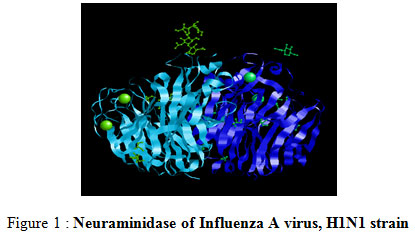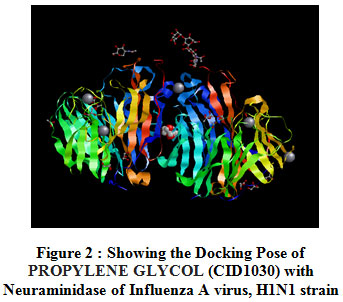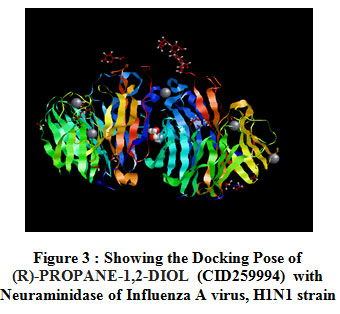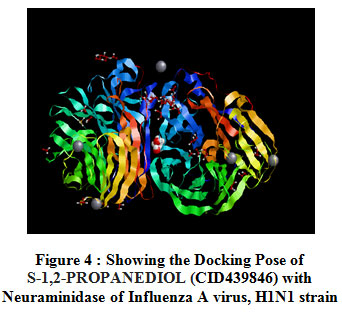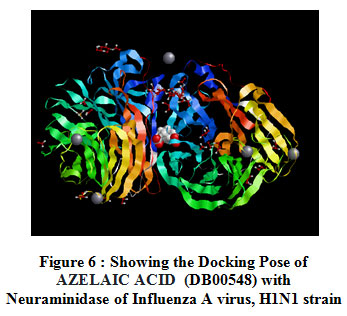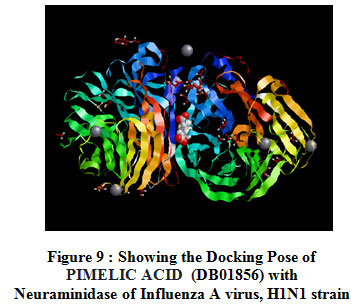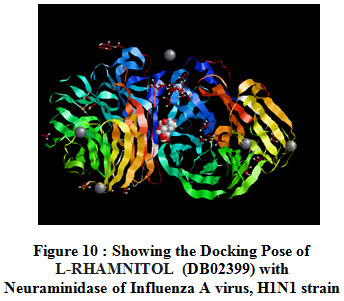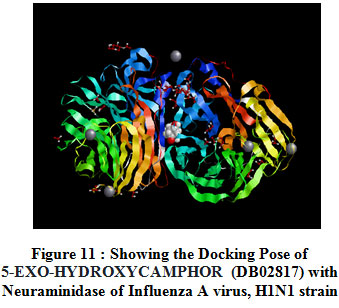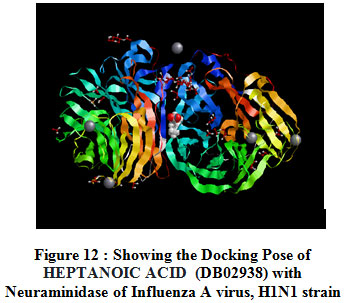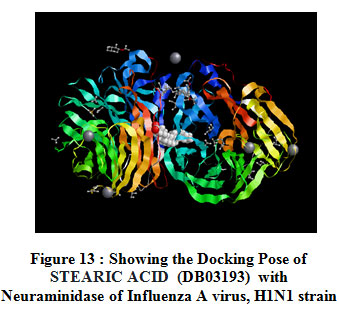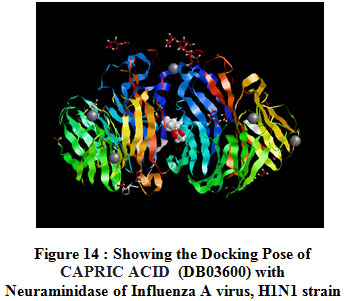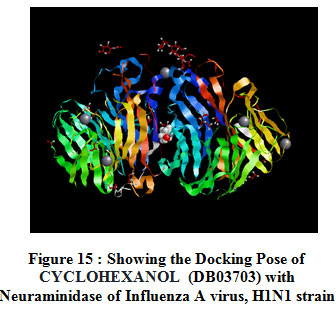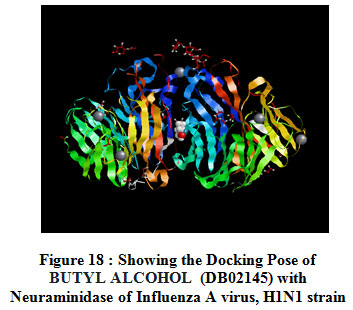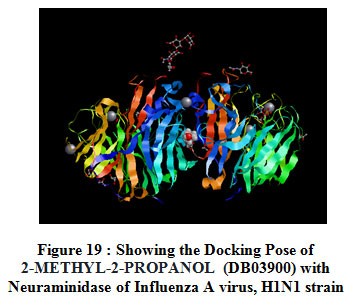1Department of Biotechnology, Hemchandracharya North Gujarat University, Patan, Gujarat, India
2Dr.Indu Dayal Meshri College of Science and Technology, Patan, Gujarat, India
Corresponding author email: arpit3290@gmail.com
Article Publishing History
Received: 05/01/2020
Accepted After Revision: 21/02/2020
H1N1 Flu (Swine Flu) protein NA (neuraminidase), assists newly prepared viruses. It is released from infected cells by cutting up sialic acids. This study was aimed at in-silico drug design and prediction of Absorption, Distribution, Metabolism, Excretion and Toxicity (ADMET) properties of potential hits against H1N1 Flu (Swine Flu) protein NA (neuraminidase). It contains ligand named Glycerol, (propane-1,2,3-triol). It was identified as a drug target protein, whose structure (PDB format) was downloaded from the Protein Data Bank. Ligand Glycerol, (propane-1,2,3-triol) was obtained for further analysis. Compounds were selected from DrugBank, PubChem, ChemSpider and they were screened along with Glycerol using PyRx-Virtual Screening software for Structure based drug design (SBDD) and compared using similarity score. Absorption, Distribution, Metabolism, Excretion and Toxicity (ADMET) properties were determined by using online tool Danish Quantitative Structure-Activity Relationship (QSAR) database. The Absorption, Distribution, Metabolism, Excretion and Toxicity (ADMET) analysis and docking results revealed 18 compounds as potential leads.
ADMET, Glycerol (propane-1,2,3-triol), Neuraminidase, Swine Flu.
Trivedi A, Dave S, Luhana K, Trivedi S. Design and Prediction of Absorption, Distribution, Metabolism, Excretion and Toxicity Properties of Drugs for H1N1 Flu (Swine Flu) Using in-Silico Approaches. Biosc.Biotech.Res.Comm. 2020;13(1).
Trivedi A, Dave S, Luhana K, Trivedi S. Design and Prediction of Absorption, Distribution, Metabolism, Excretion and Toxicity Properties of Drugs for H1N1 Flu (Swine Flu) Using in-Silico Approaches. Biosc.Biotech.Res.Comm. 2020;13(1). Available from: https://bit.ly/36bPCLL
Copyright © Trivedi et al., This is an open access article distributed under the terms of the Creative Commons Attribution License (CC-BY) https://creativecommons.org/licenses/by/4.0/, which permits unrestricted use distribution and reproduction in any medium, provide the original author and source are credited.
INTRODUCTION
In April 2009, a new strain of influenza virus A, H1N1, generally known as “swine flu,” commenced to extend in numerous countries all over the world. This new strain could pass from human to human guided the World Health Organization (WHO) to promptly elevate its pandemic awareness (Rubin, Amlôt, Page, & Wessely, 2009). Influenza A (H1N1) virus has caused severe respiratory infection and death over the years. The first confirmed case was acknowledged in May 2009 in India. H1N1 occurrence in India had directed to significant morbidity and mortality ( Kshatriya1 et al., 2018). Gujarat has its highest case fatality rate with 1674 cases and 144 deaths as on February 2015 (Baria, Solanky, Shah, & Patel, 2017).
Influenza A, influenza B, and influenza C are the three major groups of Influenza viruses. Out of these influenza A viruses are main cause of infection in Human, which is further categorized into HA (hemagglutinin) and NA(neuraminidase) (Jilani and Jamil 2019). Neuraminidase (NA) is the most significant in the pathogenesis of infection. Hence, it is the most important target for agents used in the treatment and prophylaxis of influenza (Young, Fowler, & Bush, 2001). Influenza viruses are typically round however they can also be amorphous or even form long filaments. Each virus has a membrane taken from the inflamed cellular that produced it. There are several crucial viral proteins on this outer layer giving the virus a studded appearance. Hemagglutinin allows the virus to bind to cells within the respiratory tract with binding to sialic acid on the cell surface (Jilani and Jamil, 2019).
Neuraminidase enables newly made viruses launch from infected cells by slicing up sialic acids. Matrix protein 2 (M2) is the alternative protein found inside the viral membrane. It is an ion channel. The inner of the viral membrane is lined with matrix protein 1(M1). Influenza viruses consist of a single-stranded RNA genome which encodes all the other proteins of Virus. This genome is divided into eight segments. Each and every section is covered with nucleoprotein(NP) to defend the fragile RNA (Jilani and Jamil 2019). The viral RNA polymerase catalyzes its replication and transcription (Stubbs & Te Velthuis, 2014). The RNA is replicated by means of a polymerase composed of 3 diverse kinds of proteins: Polymerase basic protein 1 (PB1), Polymerase basic protein 2 (PB2), Polymerase Acidic Protein A (PA). Altogether, the RNA, NP, and polymerase are known as a ribonucleoprotein particle (RNP). Other two viral proteins are non-structural protein 1 (NS1) and non-structural protein 2 (NS2) also present inside the virus in limited amounts. NS1 allows preventing the cell from shutting down crucial cellular pathways and detecting the virus. NS2 plays an important role in assembly of new born viruses (Jilani and Jamil 2019).
Neither presently available vaccines nor natural immunity from earlier strains of influenza A suggest protection against swine flu (Coker, 2009).To design the drug with the help of the computer is a specialized branch that uses computational approaches to create drug-receptor interactions (Bissantz, Folkers, & Rognan, 2000).These types of methods are greatly dependent on the tools of bioinformatics, applications and databases.
Many of the promising drugs fail in clinical trials after many years of research. The failuret is due to toxicity or problems with metabolism. The ADMET properties of drugs are Absorption, Distribution, Metabolism, Excretion and Toxicity in other words bioavailability and bioactivity. However these properties are typically measured in the wet lab, they can also be assumed with help of bioinformatics software and tools. The wide range of bioinformatics tools and web indexes (search engines) are available for this work (Bissantz et al., 2000; Iskar, Zeller, Zhao, Noort, & Bork, 2011). Once potential lead molecules have been identified the next step is to find their structural and ADMET properties. This commonly consists of the arrangement of changes in accordance with the essential and secondary structure of the compound. The protocol can be enhanced by using software that explores related compounds to the lead candidate (Song, Lim, & Tong, 2009).
MATERIALS AND METHODS
Target Identification: H1N1 Flu (Swine Flu) contains certain proteins. Among all these proteins Neuraminidase of Influenza A virus, H1N1 strain (figure 1) was identified as target.
Figure 1: Neuraminidase of Influenza A virus, H1N1 strain
The structure of the protein molecule was downloaded in from Protein Data Bank (PDB) with PDB ID 3BEQ. The experimental detail shows, Resolution[Å]: 1.64, R-Value: 0.180 (obs.) and R-Free:0.210.
Drug Library: Online chemical databases throughout the web were employed to obtain compounds. This mixes were screened which had related structures and properties with Glycerol, (propane-1,2,3-triol) using similarity score. Such properties like Common and IUPAC name of Compounds, Melting and Boiling Point of Compounds, pKa Value, Polarizability, Molecular Weight have been reported (Table 1) (Dias, Filgueira, & Jr, 2008; Fernando et al., 2008).
Docking: Structure files such as .sdf/.mol/.pdb of those chemical compounds were downloaded from the chemical compound database like PubChem, DrugBank, KEGG, ChemSpider. Docking was performed on the structure files of the compounds by using docking programming named PyRx. Binding energy was obtained as a result of the docking process. These chemical compounds were used for the ADMET analysis.
ADMET: ADMET properties of docked chemical substance were scrutinized in dry work experiment. ADMET properties of chemical compounds were examined by online database named Danish QSAR database. Multicase Acute Aquatic Toxicity, Carcinogenicity, Arylhydroxylase Activity, Lethal Body Burden, Bioconcentration, Mutagenicity, Biodegradation, Environmental Partitioning and General Properties etcetera are included in ADMET properties. Forty eight compounds have affirmed ADMET properties using software but out of these forty eight compounds eighteen compounds lastly fulfill maximum of the characteristics of drug target hopefuls. Thus Physical and Chemical Properties, Binding Energy and ADMET of those eighteen compounds have been shown in the outcome tables (Table:1, Table:2 and Table 3 respectively).
RESULTS AND DISCUSSION
Table 1: Physical and Chemical Properties of Chemical Compounds
|
Drug Accession Number |
State | pKa | Polarizability | Molecular Weight (g/mol) | Boiling Point | Melting Point |
Log P |
| CID 1030 | Liquid | 14.9 | NA | 76.095 | 187.6 °C | -60 °C | -0.92 |
| CID 259994 | NA | NA | NA | 76.095 | NA | NA | NA |
| CID 439846 | Solid | NA | NA | 76.095 | NA | NA | NA |
| DB00302 | Solid | (Acidic)4.56, (Basic) 10.22 | 17.28 Å3 | 157.2102 | NA | >300 °C | 0.3 |
| DB00548 | Solid | 4.55 (at 25 °C) | 20.5 Å3 | 188.2209 | 286.5 °C | 106.5 °C | 1.57 |
| DB00858 | Solid | (Acidic)19.39, (Basic) -0.88 | 36.79 Å3 | 304.4669 | NA | 151 °C | 3.99 |
| DB01561 | Solid | (Acidic)19.78, (Basic) -7.1 | 33.84 Å3 | 288.4244 | NA | NA | 3.97 |
| DB01856 | Solid | 4.51 (at 25 °C) | 4.51 (at 25 °C) | 160.1678 | 342 °C | 106 °C | 0.51 |
| DB02399 | Solid | (Acidic)12.7, (Basic)-3 | 16.25 Å3 | 166.1724 | NA | NA | -2.7 |
| DB02817 | Solid | (Acidic)14.88, (Basic) -2.9 | 18.62 Å3 | 168.2328 | NA | NA | 1.24 |
| DB02938 | Solid | 5.15 | 15.33 Å3 | 130.1849 | NA | NA | 2.41 |
| DB03193 | Solid | 4.95 | 38.64 Å3 | 284.4772 | 383 °C | 68.8 °C | 8.23 |
| DB03600 | Solid | 4.9 | 21.61 Å3 | 172.2646 | 268.7 °C | 31.9 °C | 4.09 |
| DB03703 | Solid | (Acidic)18.18, (Basic) -1.4 | -0.44 | 100.1589 | 160.8 °C | 25.4 °C | 1.23 |
| DB03741 | Solid | 4.97 | 10.99 Å3 | 102.1317 | NA | NA | 1.47 |
| DB01637 | Solid | (Acidic)17.11, (Basic) -1.9 | 41.01 Å3 | 298.5469 | NA | NA | 8.18 |
| DB02145 | Solid | 16.1 (at 25 °C) | 9.21 Å3 | 74.1216 | 117.7 °C | -89.8 °C | 0.88 |
| DB03900 | Solid | (Acidic) 18.03, (Basic) -1.4 | 8.94 Å3 | 74.1216 | NA | NA | 0.54 |
Table 2: Showing Binding Energy of Chemical Compounds
| Drug Accession Number | Binding energy |
| CID1030 | -3.1 |
| CID259994 | -3.1 |
| CID439846 | -3.2 |
| DB00302 | -5.9 |
| DB00548 | -5.2 |
| DB00858 | -8.7 |
| DB01561 | -7.8 |
| DB01856 | -8.5 |
| DB02399 | -4.9 |
| DB02817 | -6.2 |
| DB02938 | -4.3 |
| DB03193 | -5.3 |
| DB03600 | -4.8 |
| DB03703 | -4.1 |
| DB03741 | -4.2 |
| DB01637 | -5.7 |
| DB02145 | -.3.5 |
| DB03900 | -3.2 |
Table 3: Absorption, Distribution, Metabolism, Excretion and Toxicity Properties
| Drug Accession Number | Health End Point | Mutagenicity | In Vitro Tests | Carcinogenicity | ||
| Severe skin irritation
|
Skin sensitization
|
Respiratory sensitization | Ames test (Salmonella) | HGPRT | ||
| CID1030 | NEG | NEG | NEG | NEG | NEG | NEG |
| CID259994 | NEG | NEG | NEG | NEG | NEG | NEG |
| CID439846 | NEG | NEG | NEG | POS | NEG | NEG |
| DB00302 | POS | NEG | POS | NEG | POS | NEG |
| DB00548 | NEG | NEG | POS | NEG | NEG | NEG |
| DB00858 | NEG | NEG | NEG | NEG | NEG | NEG |
| DB01561 | NEG | NEG | NEG | NEG | NEG | NEG |
| DB01856 | NEG | NEG | POS | NEG | NEG | NEG |
| DB02399 | NEG | POS | POS | NEG | NEG | NEG |
| DB02817 | NEG | NEG | NEG | NEG | NEG | POS |
| DB02938 | NEG | NEG | NEG | POS | NEG | NEG |
| DB03193 | NEG | NEG | NEG | NEG | NEG | NEG |
| DB03600 | POS | NEG | NEG | NEG | NEG | NEG |
| DB03703 | NEG | NEG | POS | NEG | POS | NEG |
| DB03741 | NEG | POS | NEG | NEG | NEG | NEG |
| DB01637 | NEG | NEG | NEG | NEG | NEG | POS |
| DB02145 | NEG | NEG | POS | NEG | NEG | NEG |
| DB03900 | NEG | NEG | NEG | NEG | NEG | NEG |
( * POS = POSITIVE) (* NEG =NEGATIVE)
Figure 2 : Showing the Docking Pose of Propylene Glycol (CID1030) with Neuraminidase of Influenza A virus, H1N1 strain
Figure 3: Showing the Docking Pose of (R)-Propane-1,2-diol (CID259994) with Neuraminidase of Influenza A virus, H1N1 strain
Figure 4 : Showing the Docking Pose of S-1,2-Propanediol (CID439846) with Neuraminidase of Influenza A virus, H1N1 strain
Figure 5 : Showing the Docking Pose of Tranexamic Acid (DB00302) with Neuraminidase of Influenza A virus, H1N1 strain
Figure 6 : Showing the Docking Pose of Azelaic Acid (DB00548) with Neuraminidase of Influenza A virus, H1N1 strain
Figure 7 : Showing the Docking Pose of Drostanolone (DB00858) with Neuraminidase of Influenza A virus, H1N1 strain
Figure 8 : Showing the Docking Pose of Androstanedione (DB01561) with Neuraminidase of Influenza A virus, H1N1 strain
Figure 9 : Showing the Docking Pose of Pimelic Acid (DB01856) with Neuraminidase of Influenza A virus, H1N1 strain
Figure 10 : Showing the Docking Pose of L-Rhamnitol (DB02399) with Neuraminidase of Influenza A virus, H1N1 strain
Figure 11 : Showing the Docking Pose of 5-Exo-Hydroxycamphor (DB02817) with Neuraminidase of Influenza A virus, H1N1 strain
Figure 12 : Showing the Docking Pose of Heptanoic Acid (DB02938) with Neuraminidase of Influenza A virus, H1N1 strain
Figure 13 : Showing the Docking Pose of Stearic acid (DB03193) with Neuraminidase of Influenza A virus, H1N1 strain
Figure 14 : Showing the Docking Pose of Capric acid (DB03600) with Neuraminidase of Influenza A virus, H1N1 strain
Figure 15 : Showing the Docking Pose of Cyclohexanol (DB03703) with Neuraminidase of Influenza A virus, H1N1 strain
Figure 16 : Showing the Docking Pose of 2-Methylbutanoic Acid (DB03741) with Neuraminidase of Influenza A virus, H1N1 strain
Figure 17 : Showing the Docking Pose of 3,7,11,15-Tetramethyl-Hexadecan-1-Ol (DB01637) with Neuraminidase of Influenza A virus, H1N1 strain
Figure 18 : Showing the Docking Pose of Butyl alcohol (DB02145) with Neuraminidase of Influenza A virus, H1N1 strain
Figure 19 : Showing the Docking Pose of 2-Methyl-2-Propanol (DB03900) with Neuraminidase of Influenza A virus, H1N1 strain
In this work total 75 chemical compounds were screened as drug target candidate for Neuraminidase of Influenza A virus, H1N1 strain. Chemical and physical properties of these compounds were collected from chemical database. These properties such as pKa value, Molecular weight(MW), its state, Polarizibility, Melting and Boiling Point play essential role in the drug molecule (Dias & de Azevedo Jr., 2008).
A weak acid incorporates a pKa worth within the scope between -2 to 12 and pKa values over twelve area unit are said to be alkaline drug. Acid with a pKa worth of less concerning -2 area units are said to be a strong acid. Similarity score denotes relevance of the new chemical with the chemical which may fit the drug target pocket.Polarizability shows the ability of a molecule to be polar; it is dependent upon the charge distribution and effects the bond formation in a chemical compound.Docking results denote that lower binding energy show the higher affinity of the drug target candidate (Modis, Ogata, Clements, & Harrison, 2003).
Every drug must comply with its ADMET properties. Amongst all their properties Mutagenicity, Toxicity, In-vitro test and Carcinogenicity are important properties of drug candidates to be examined. Preferably these properties are examined by tests like Ames test, Food and Drug Administration’s Center for Drug Evaluation and Research (FDA- CDER) properties on RAT and Mouse, Lethal Concentration, Lethal Dose in human, and Hypoxanthine-guannine phosphoribosyltransferase (HGPRT) test. These properties can also be predicted using ADMET software (Yang & Chen, 2004).
Table 3 enlists skin irritation, skin sensitization, Respiratory sensitization and other properties of these molecules. Most of the molecules show negative skin sensitization, skin irritation, respiratory irritation and negative Ames and Hypoxanthine-guannine phosphoribosyltransferase (HGPRT) test indicates that these molecules can be considered as suitable hits for further drug design.Ames test can be utilized to check mutagenicity of the drug. Positive result indicates that the drug will be the mutagenic (Wadood et al., 2013; Williamson, 2014). CID439846, DB02938 compounds demonstrate positive Ames test, thereupon they are mutagenic and can only be used as drug target candidates after bringing changes in their molecular structure. Remaining compounds show negative Ames test; thus they are not mutagenic and can be considered as drug target candidates.
Certain tests such as-CDER Proprietary Male Rat, FDA Cancer Male Rat, FDA Cancer Female Rat, FDA Cancer Male Mouse, CDER Proprietary Male Mouse, FDA Cancer Female Mouse, -CDER Proprietary Female Rat, -CDER Proprietary Female Mouse are used to determine carcinogenicity. Positive result denotes that the drug will be the carcinogenic(Wadood et al., 2013; Williamson, 2014) DB02817, DB01637 compounds indicate positive carcinogenicity thence they can only be considered as drug candidates after modification in the structure. Remaining compounds show negative carcinogenicity thus they are not carcinogenic and can be considered as drug target candidates.
Lethal dose is a way to determine the short term poisoning potential of the material. Lethal concentration values solicit the concentration of the chemical. This toxicity is established on lethal concentration of the drug. The range of lethal concentration 100 – 1000mg/L indicates moderately toxicity of compound and based on that concentration lethal dose is set as 0.5-5 gm/kg. If lethal concentration range is 10 -100 mg/L then it indicates highly toxicity of the substance and hence lethal dose has to be 5-50 mg /kg. If lethal concentration range is 1000 – 10000 mg/L then it indicates slightly toxicity of the compounds and lethal dose is set as 5 – 15 gm/ kg (Wadood et al., 2013; Williamson, 2014).
Here screened each of the eighteen compounds have lethal concentration range 100 – 1000 mg/L thus they are sensibly toxic and their lethal dose should be 0.5 – 5 gm/Kg. After evaluating physical and chemical properties, docking and ADMET analysis of all the screened chemical compounds we validate below chemical compounds as potential lead molecules for Neuraminidase of Influenza A virus, H1N1 strain. Propylene Glycol – (CID1030), (R)-Propane-1,2-diol – (CID259994), S-1,2-Propanediol- (CID439846), Tranexamic Acid – (DB00302), Azelaic Acid – (DB00548), Drostanolone – (DB00858), Androstanedione – (DB01561), Pimelic Acid – (DB01856), L-Rhamnitol – (DB02399), 5-Exo-Hydroxycamphor – (DB02817), Heptanoic Acid – (DB02938), Stearic acid – (DB03193), Capric acid – (DB03600), Cyclohexanol – (DB03703), 2-Methylbutanoic Acid – (DB03741), 3,7,11,15-Tetramethyl-Hexadecan-1-Ol – (DB01637), Butyl alcohol – (DB02145), 2-Methyl-2-Propanol – (DB03900) Chemical Compounds apart from these are missing in above criteria. Thus, those chemical compounds can’t be employed in present form as drug candidate for the same target.
SUMMARY AND CONCLUSION
Swine flu protein NA (neuraminidase), assists newly prepared viruses. It release from infected cells by cutting up sialic acids. It contains ligand named Glycerol, (propane-1,2,3-triol). It was identified as a Drug Target protein. The structure of protein (PDB format) was downloaded from the Protein Data Bank. Ligand Glycerol, (propane-1,2,3-triol) was obtained for further analysis. Similar structure search of different chemical compounds was done which were related to Glycerol, (propane-1,2,3-triol). Lastly, 75 structures were obtained with their physical and chemical properties. Further, Docking and Screening were performed. ADMET study was done. At the end of ADMET analysis forty eight Chemical compounds were found to affect Protein Target.
Further, all parameters of those forty eight chemical compounds were analyzed and following eighteen chemical compounds confirm their potential as drug target candidates. Propylene Glycol – (CID1030), (R)-Propane-1,2-diol – (CID259994), S-1,2-Propanediol- (CID439846), Tranexamic Acid – (DB00302), Azelaic Acid – (DB00548), Drostanolone – (DB00858), Androstanedione – (DB01561), Pimelic Acid – (DB01856), L-Rhamnitol – (DB02399), 5-Exo-Hydroxycamphor – (DB02817), Heptanoic Acid – (DB02938), Stearic acid – (DB03193), Capric acid – (DB03600), Cyclohexanol – (DB03703), 2-Methylbutanoic Acid – (DB03741), 3,7,11,15-Tetramethyl-Hexadecan-1-Ol – (DB01637), Butyl alcohol – (DB02145), 2-Methyl-2-Propanol – (DB03900). From the above eighteen compounds these two are hormone derivatives : Drostanolone – (DB00858), Androstanedione – (DB01561).
Thus it can be concluded that above eighteen chemical compounds show great affinity against H1N1 Flu (Swine Flu). Hence, these eighteen chemical compounds can be further analyzed as drug target candidates for H1N1 Flu (Swine Flu) in wet lab for the development of new drug.
ACKNOWLEDGEMENTS
This study was supported by Dr. Indu Dayal Meshri College of Science and Technology and the department of Biotechnology, Hemchandracharya North Gujarat University, Patan, Gujarat, India for Ph.D scholar.
Conflict of Interest Statement: We, the authors of the submitted manuscript declare that the work and data present in the manuscript entitled – Design and prediction of Absorption, Distribution, Metabolism, Excretion and Toxicity properties of drugs for H1N1 Flu (Swine Flu) using in-silico approaches is genuine research carried out by us. The work finally belongs to the institutes. We have not misused the data previously published and also have not manipulated the original work.
REFERENCES
Baria, H. G., Solanky, P., Shah, H., & Patel, R. (2017). A study on swine flu (H1N1) awareness among college students of Valsad city. International Journal Of Community Medicine And Public Health, 4(10), 3668–3672. https://doi.org/10.18203/2394-6040.ijcmph20174231
Bissantz, C., Folkers, G., & Rognan, D. (2000). Protein-Based Virtual Screening of Chemical Databases . 1 . Evaluation of Different Docking / Scoring Combinations. J. Med. Chem., 43, 4759–4767.
Coker, R. (2009). Swine flu. BMJ, 10(2), 338–340. https://doi.org/10.3329/jom.v10i2.2810
Dias, R., & de Azevedo Jr., W. (2008). Molecular Docking Algorithms. Current Drug Targets, 9(12), 1040–1047. https://doi.org/10.2174/138945008786949432
Iskar, M., Zeller, G., Zhao, X., Noort, V. Van, & Bork, P. (2011). Drug discovery in the age of systems biology : the rise of computational approaches for data integration. Current Opinion in Biotechnology, 23, 1–8. https://doi.org/10.1016/j.copbio.2011.11.010
Jilani TN, Jamil RT, S. A. (2019). H1N1 Influenza (Swine Flu). Retrieved from https://www.ncbi.nlm.nih.gov/books/NBK513241/
Modis, Y., Ogata, S., Clements, D., & Harrison, S. C. (2003). A ligand-binding pocket in the dengue virus envelope glycoprotein. Proceedings of the National Academy of Sciences of the United States of America, 100(12), 6986–6991. https://doi.org/10.1073/pnas.0832193100
M. Kshatriya1, N. V. K., Ganjiwale, J., & , S. D. Lote, S. N. Patel1, R. P. P. (2018). Lessons learnt from the Indian H1N1 (swine flu) epidemic: Predictors of outcome based on epidemiological and clinical profile. Journal of Family Medicine and Primary Care, 7(6), 1506–1509. https://doi.org/10.4103/jfmpc.jfmpc
Rubin, G. J., Amlôt, R., Page, L., & Wessely, S. (2009). Public perceptions, anxiety, and behaviour change in relation to the swine flu outbreak: Cross sectional telephone survey. BMJ (Online), 339(7713), 156. https://doi.org/10.1136/bmj.b2651
Song, C. M., Lim, S. J., & Tong, J. C. (2009). Recent advances in computer-aided drug design. Briefings in Bioinformatics, 10(5), 579–591. https://doi.org/10.1093/bib/bbp023
Stubbs, T. M., & Te Velthuis, A. J. W. (2014). The RNA-dependent RNA polymerase of the influenza A virus. Future Virology, 9(9), 863–876. https://doi.org/10.2217/fvl.14.66
Wadood, A., Ahmed, N., Shah, L., Ahmad, A., Hassan, H., & Shams, S. (2013). In-silico drug design : An approach which revolutionarised the drug discovery process In-silico drug design : An approach which revolutionarised the drug discovery process. OA Drug Design & Delivery, 1(1), 1–4. https://doi.org/10.13172/2054-4057-1-1-1119
Williamson, E. M. (2014). Synergy : Interactions within Herbal Medicines Synergy and other interactions in phytomedicines. Phytomedicine, 8(5), 401–409.
Yang, J., & Chen, C. (2004). GEMDOCK : A Generic Evolutionary Method for Molecular Docking. Proteins: Structure, Function, and Bioinformatics, 55, 288–304. https://doi.org/10.1002/prot.20035
Young, D., Fowler, C., & Bush, K. (2001). RWJ-270201 (BCX-1812): A novel neuraminidase inhibitor for influenza. Philosophical Transactions of the Royal Society B: Biological Sciences, 356(1416), 1905–1913. https://doi.org/10.1098/rstb.2001.1004

